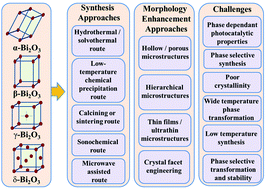A review on the preparation, microstructure, and photocatalytic performance of Bi2O3 in polymorphs
Abstract
In recent years, the semiconductor bismuth oxide (Bi2O3) has attracted increasing attention as a potential visible-light-driven photocatalyst due to its simple composition, relatively narrow bandgap (2.2–2.8 eV), and high oxidation ability with deep valence band levels. Owing to the symmetry of its unit cell, Bi2O3 exists in more than one crystal form and exhibits phase-dependent photocatalytic properties. However, the phase-selective synthesis of Bi2O3 is a complex process, and its phase transformation usually occurs in a wide temperature range. Therefore, the development of Bi2O3 phases with a controllable microstructure and good photocatalytic properties is a great challenge. Hundreds of articles have been reported on the phase-selective synthesis and photocatalytic performance of Bi2O3. However, an interacting and critical review has rarely been reported, and thus it is essential to fill the gap in the literature. In this review, the phase-dependent photocatalytic performance of Bi2O3 is presented in detail. The phase-selective synthesis and temperature-dependent phase stability of highly active Bi2O3 are explored. The phase junction in Bi2O3 is reviewed, and the future perspective with an outlook on contemporary challenges is provided finally.

- This article is part of the themed collections: Nanoscale 2022 Lunar New Year Collection, Nanoscale Most Popular 2021 Articles and Recent Review Articles


 Please wait while we load your content...
Please wait while we load your content...